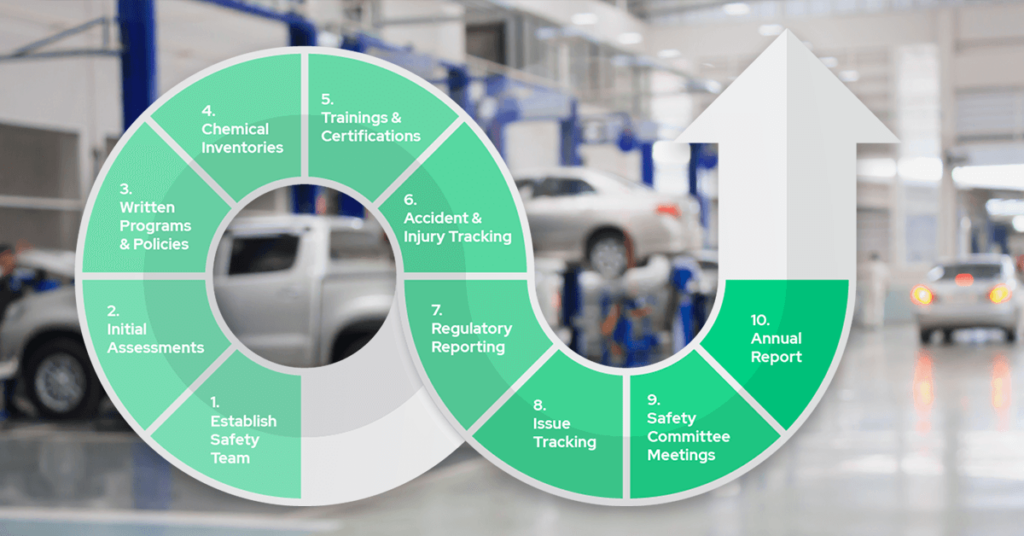Running a successful auto dealership means keeping your employees safe and your business compliant. But with complex regulations and constant operational demands, building an effective Environment, Health & Safety (EHS) program can feel overwhelming.
That’s why we’ve created this comprehensive guide to EHS compliance. Over the next 10 weeks, we’ll break down the essential steps every dealership needs to take to build and maintain a successful safety program.
Why Your Dealership Needs a Systematic Approach to Safety
Auto dealerships face unique safety challenges. From lift equipment and chemical handling in service departments to operational risks throughout your facility, maintaining compliance requires more than just checking boxes. You need a comprehensive system that protects your people and your business.
Follow a 10-step journey to compliance.
Move your mouse over each step to learn more about each step.
Our Better Workforce Blog is your Ultimate Guide!
Stay informed with weekly industry updates, expert insights, best practices, and actionable tips to enhance workplace safety and compliance.
Meet Our Safety Experts
Leading us through this journey are two of KPA’s most experienced EHS professionals:

Zach Pucillo, CSP, CHMM brings 18 years of environmental health and safety expertise to the table. As KPA’s EHS Compliance Manager, Zach helps companies build positive safety cultures while ensuring regulatory compliance. His expertise has earned him recognition from the National Safety Council as a Rising Star of Safety, and he was named Hazardous Materials Professional of the Year by the Alliance of Hazardous Materials Professionals.

Stephany Birkholz, CHMM, REP, is KPA’s EHS Regulatory Project Manager. She brings valuable perspective from her time as a hazardous waste and used oil inspector with the Florida Department of Environmental Protection. Her environmental science background and hands-on experience help dealers navigate complex compliance requirements.
The 10 Essential Steps to EHS Compliance
Here’s a preview of the critical steps we’ll explore in detail over the coming weeks:
Making It Work Together
These steps aren’t isolated tasks—they’re interconnected elements of a comprehensive safety program. Each builds on the others to create a culture of safety that protects your people and your business.
“I’ve seen way too many facilities try to run safety programs without dedicated teams,” explains Zach Pucillo. “It usually results in expired training, missing documentation, and confusion during emergencies. The good news is, it doesn’t take a massive staff to run an effective safety program.”
Stephany Birkholz emphasizes the importance of systematic tracking and analysis: “It’s unreasonable to think you can just establish a safety team and immediately have everything figured out perfectly. You need to know exactly what you’re working with through comprehensive initial assessments to create a realistic implementation roadmap for your dealership.”
Stay Informed
Over the next 10 weeks, we’ll examine each of these steps, providing practical guidance and expert insights to help you build a stronger safety program. Subscribe to our weekly newsletter to ensure you don’t miss this valuable information.
Complete Dealership Compliance from KPA
Keep your dealership safe from environmental factors that impact your workers’ and customers’ safety. KPA helps auto dealers maintain cultures of safety, streamline operations, and manage risk through a robust set of tools that includes a combination of consulting, training, and regulatory content.
Related Content
Explore more comprehensive articles, specialized guides, and insightful interviews selected, offering fresh insights, data-driven analysis, and expert perspectives.

